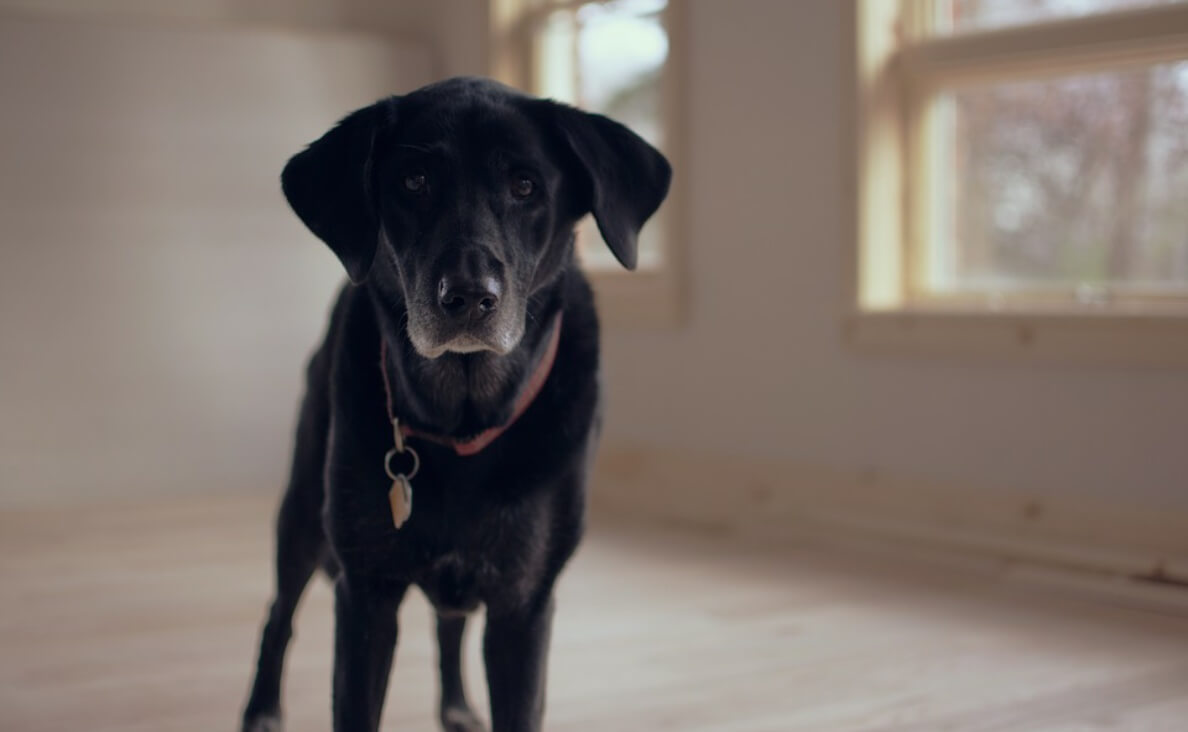
Like humans, dogs tend to suffer from failing hearing and diminishing eyesight as they age. It can be disorienting and stressful for aging dogs to experience these changes. Dog parents can help by understanding what’s happening and developing coping strategies for hearing and vision loss.
Hearing Impairment in Dogs
Hearing loss is a slow process in dogs, just like people. It may seem like it’s something that has happened suddenly, but in reality, it has taken time for the hearing loss to become noticeable. Owners often miss the first stages of age-related hearing loss because dogs rarely give us clues. Dogs often lose certain frequencies first, so they may hear a man’s deep voice but not a woman’s higher-pitched vocals.

Other signs to look for include:
- Being startled when you touch them
- Not reacting to sounds they used to (like thunder)
- Difficult to wake when sleeping
- Being more vocal in their demands
- Ears remain still instead of moving around to hear
Hearing impairment in dogs is due to loss of the hair cells of the inner ear. These cells pick up sound vibrations and send them to the brain for interpretation.
It’s common for dogs to lose their hearing in one ear first. When this happens, they may seem confused and unable to find you because they are no able to pinpoint the sound of your voice.

A simple test you can perform to see if there is any hearing loss is to snap your fingers behind your dog’s head. Look for a response – a startle reflex or they should at least look at you. If there’s no reaction, try clapping your hands. If there’s still no response, their hearing is most likely gone.
Vision Loss in Dogs
When a dog’s sight is failing you will notice them bumping into things and acting hesitant to go down stairs. They will also have trouble navigating curbs and sidewalks. When it’s dark outside, your dog might run into trees and bushes.
Other signs to look for include:
- Not recognizing you from a distance
- Not able to catch balls or other objects like they used to
- Change of the look or color of their eyes
In order to test your dog’s vision, turn down the lighting to where you can just see. Then, place cardboard boxes in the hallway. If your dog has trouble navigating the boxes, he or she may have a vision problem.

Possible Causes of Vision Impairment
Once you’ve identified your dog has loss of vision, a diagnosis is in order. It is imperative you make an appointment with your veterinarian if you suspect your dog has vision loss.
Possible causes include:
- Glaucoma – acute vision loss and painful, red eyes; emergency treatment is needed
- Cataracts – white opacities in the lens of the eye; may be associated with diabetes
- Nuclear sclerosis – graying of the eye lens commonly seen in dogs over eight years of age
- Progressive retinal atrophy – affects the back of the eye through the deterioration of the retina. Will eventually cause blindness.
What You Can Do
If your dog is suffering loss of vision, it’s not the end of the world. Dogs with vision loss or even complete blindness are able to function as long as you don’t change their routine. They can go out in a fenced yard and navigate back to the door using familiar landmarks. You can guide them using short, plastic fencing. Use audible commands instead of visual clues.

Most of the time older dogs only lose part of their ability to see. Ensure your dog has strong lighting, such as a patio and stair lights. A nightlight in the hallway can be helpful as well.
Make sure you protect your dog by blocking off stairs with a baby gate. Keep the furniture in its place so your dog can find his or her way around. Make sure food and water is easily accessible and don’t move the dishes around. In addition to a dog tag or vest, you can get a blind dog guiding device to help your dog be safe when walking around, and a locator sound ball if your dog still loves to chase balls.
If you suspect your dog has hearing loss, use hand signals to communicate with them. Stay with them in a new environment, at least until they feel comfortable. You can also get a “Deaf Dog” tag or vest to alert others to your dog’s condition.
While it sounds scary for them to lose hearing and sight, they usually still have a strong sense of smell to rely on. It’s amazing how they will learn to identify and navigate their environment.

Finally, keep in mind your dog may be experiencing stress due to these physical changes and discuss it with your veterinarian. Your vet may want to prescribe medication or may offer other suggestions to help ease your dog’s stress level.
Have you had a dog who lost hearing or vision ability? How did you help your pet adjust?


 What to Put in a Dog First Aid Kit
What to Put in a Dog First Aid Kit How to Choose the Best Dog Bed for Your Dog
How to Choose the Best Dog Bed for Your Dog How to Recognize and Manage Cognitive Dysfunction in Aging Dogs
How to Recognize and Manage Cognitive Dysfunction in Aging Dogs How Many Chromosomes Do Dogs Have and What They Mean
How Many Chromosomes Do Dogs Have and What They Mean






Leave a Reply